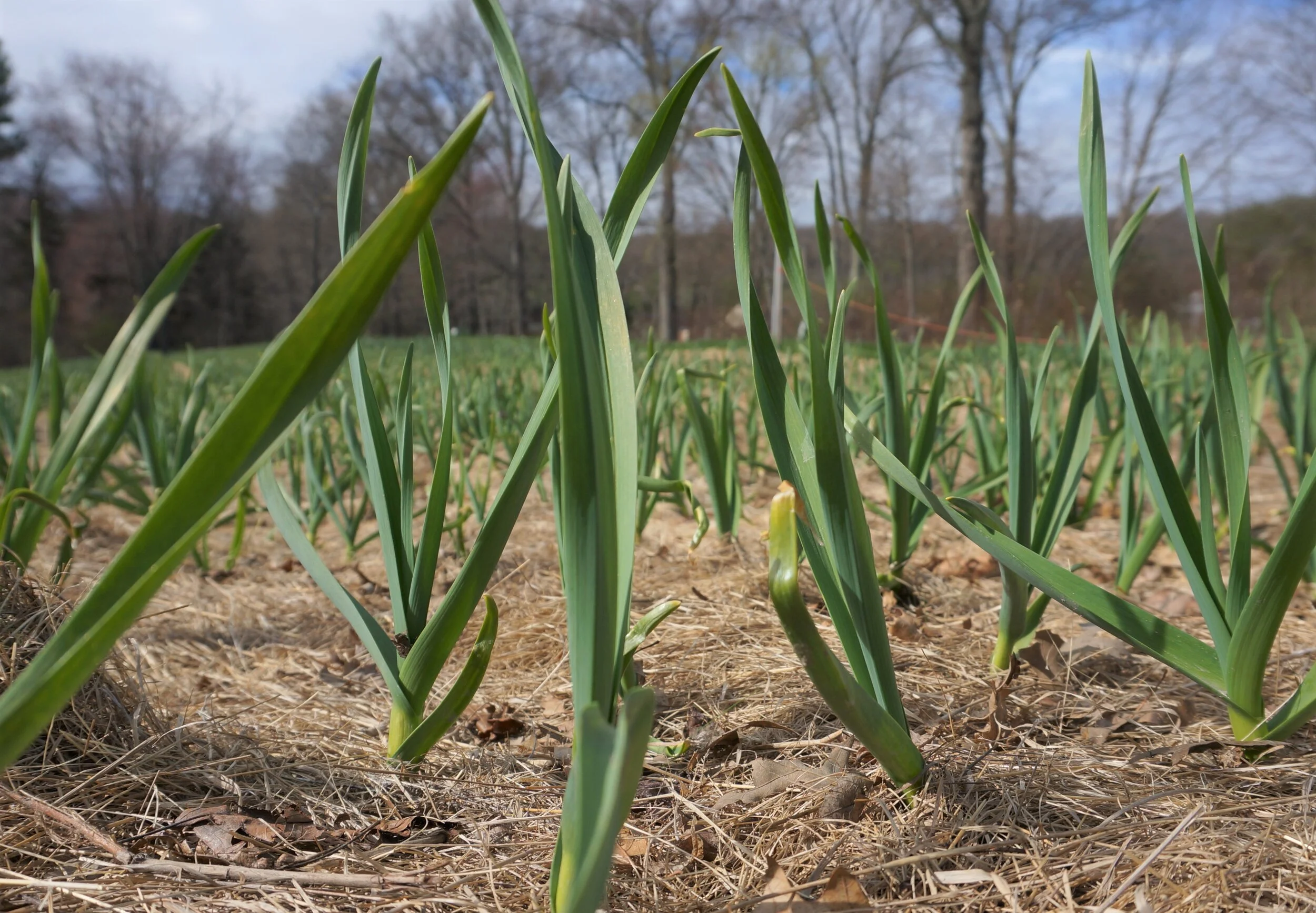How to grow garlic
Garlic field growing in Massachusetts. Photo source: Trish Wesley Umbrell for Natick Community Organic Farm
Allium sativum, or garlic, is my spirit vegetable. It’s my way of expressing massive appreciation for this plant, which I have used as a medicine, an herbal flavoring, a culinary staple, and a standalone treat. Its fans are legion, gathering at events like the Gilroy Garlic Festival in California, the state that grows the vast majority of the country’s garlic (most of which is then dehydrated into powder for processed food), and the North Quabbin Garlic & Arts Festival in central Massachusetts, where heirloom varieties from small farms reign supreme.
Garlic probably originated somewhere in middle Asia, but there’s evidence of it growing all over the ancient world, including India, China, Greece, Rome, and Egypt. It’s mentioned in many ancient medical guides, including the Papyrus Ebers from around 1550 BCE, and preserved garlic cloves have been found in Egyptian tombs and temples, including that of the Pharaoh Tutankhamen (buried in 1325 BCE).
Allium depicted in the Vienna Dioscorides’ manuscript (circa 512 CE)
The garlic family includes onions, leeks, and chives. They all contain sulfuric compounds including allicin, which has clinically-proven benefits, including antimicrobial and antibiotic properties, and has been shown to effectively treat high blood cholesterol and high blood pressure.
So how do you bring this ancient medicinal powerhouse to your garden? With some basic rules of thumb, garlic is fairly easy to grow in your sunny backyard or inside in pots. Stone Pier Press’ resident farmer Acadia Tucker shows us how, with a full growing guide found here, and the basics below.
CHOICES: Garlic grown in the US is commonly split into two kinds: softneck and hardneck. Softneck varieties, often better suited to warmer growing zones, will produce many cloves and keep longer than five to eight months. Hardneck varieties are more suited to northern zones, and will grow a unique curly scape and flowers. While hardneck garlic bulbs usually contain fewer cloves, they tend to be larger with a spicier flavor.
WHEN: Garlic is seeded by cloves, and usually planted in the fall, since it needs roughly six to twelve weeks of cold temperatures to develop harvestable bulbs. Acadia suggests that if you’re planting garlic in a warm, frost-free climate, chill the cloves before planting by storing them in the fridge for up to twelve weeks. You can plant garlic in the spring but without cold conditioning, a clove won’t produce additional cloves. It’s also often impossible to find seeding cloves in the spring since the seed companies only sell in the fall.
A summer garlic harvest. Photo source: Trish Wesley Umbrell for Natick Community Organic Farm.
HOW: Plant it about one month before the ground freezes, in well-draining soil, and be sure to apply mulch to protect it against the winter chill. Leave it be over the winter, and then water your garlic every three to five days in spring when the bulb is forming. Don't water it after July or the bulbs may rot. Consider harvesting your garlic early if you're experiencing a particularly wet summer.
Growing in pots: Acadia says you can follow the same directions for growing garlic in a pot: plant in the fall and overwinter the garlic in the pot. If you’d like to grow garlic in the spring, she suggests you “sprout your garlic before you plant it. You can place cloves in a shallow dish of water and they will start to grow!” For more information growing food in pots, check out Tiny Victory Gardens.
HARVEST, EAT: If you harvest only the big plants and leave behind the small ones, you’ll have a perennial garlic that regrows every year. Acadia suggests hanging your garlic bulbs in a shady, dry, warm spot for a couple of weeks to cure. Once dry, you can store them with the wrappers still on. Garlic flavor only increases when dried.
Finally, may I recommend a Roasted Garlic Spread, or a Spinach Artichoke Pasta with Garlic bread crumbs, or a Quick Garlicky Kale dish? Really, I can’t get enough of it.
Stephanie Damplo Luke is a Stone Pier Press News Fellow. She’s also an earth-worker and artist, and professionally a marketing specialist and designer with a focus on sustainable agriculture and environmentalism. She lives in GA, via CA, from MA.











